 Page: 1 2
Page: 1 2
Car Powertrain Basics, How-To & Design Tips cont…
Powertrain Configurations cont…
Front Engine/Front Drive
Used in many modern production-based race cars and most road cars, the front engine/front drive configuration shown in diagram PC2 below is generally at a disadvantage when placed on a race track with front engine/rear drive cars of equal spec. This configuration, while still potentially capable of a good static front/rear balance, requires the front tires to both steer and provide drive. This reduces the overall traction available for turning and accelerating/braking which in turn creates understeer.
The acceleration potential is also less than rear wheel drive configurations. As the weight shifts off the front tires and onto the rear tires during acceleration, there is less grip to drive the vehicle forward, which creates front wheel spin that hampers acceleration and increases tire wear.
However, front wheel drive cars generally have the advantage of being lower in cost than other drive configurations due to the integrated packaging and they represent great value in racing when matched against other front wheel drive machines.
Applications: AutoCross/Solo, Custom Street/Import, Rally, Touring Car
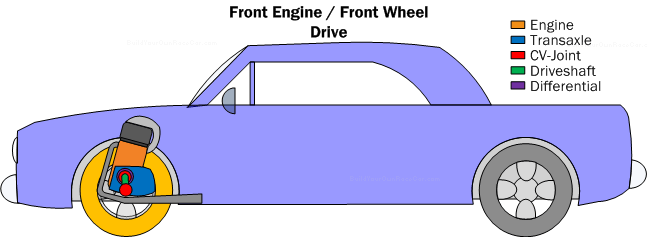
Diagram PC3. Front engine/front wheel drive powertrain configuration.
Front Engine/Four Wheel Drive
The vehicle in diagram PC3 below shows a front engine/4WD configuration. Four wheel drive itself provides a significant advantage in acceleration, but adds additional weight and complexity to the vehicle.
It can enhance braking through the use of engine braking, but overall grip available at the tire contact patches will remain the same. The same situation exists for cornering. Four wheel drive might help avoid oversteer by more evenly applying acceleration forces through all four wheels, but the overall lateral and longitudinal grip remains the same.
The front engine combined with the 4WD driveline may bias the weight toward the front of vehicle, but a balanced Front/rear distribution is still quite possible with rearward placement of other components.
Applications: AutoCross/Solo, Dune Buggy, Off-road Truck, Pickup truck (Custom Off-road), Rally, Supercar
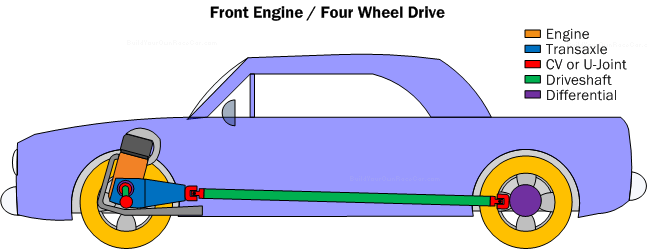
Diagram PC3. Front engine/four wheel drive powertrain configuration. Maximum acceleration is possible with all four wheels driving, but weight distribution and suspension design are still key to putting down the power efficiently.
Mid-Engine/Rear Drive
The mid-mounted engine / rear drive configuration, demonstrated by the sample car in diagram PC4 below, was pioneered for racing by Auto Union in the 1930s. At the time, the suspension, handling and driving techniques were undeveloped but once those aspects were worked out, the Auto Union cars became formidable race cars. This configuration continued in the late 1950s/60s and today is the dominant configuration for formula cars and sports cars.
Mid-engine cars offer several distinct advantages: For lightweight racers, it is easier to achieve a balanced front/rear weight distribution. By having the engine, transmission and final drive in close proximity it also reduces weight because fewer and shorter components are needed to form the driveline.
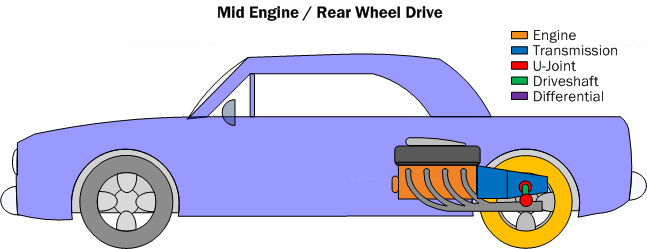
Diagram PC4. Mid-Engine/Rear Wheel Drive powertrain configuration has multiple advantages which enable it to handle very well.
By having the engine behind the driver, it also shortens the required length of the car and reduces the height of the front bodywork, allowing the driver to sit lower, which in turn lowers CG. The polar moment of inertia is reduced because the engine sits much closer to the CG point as well. What these advantages add up to is a more nimble car—quicker to turn, brake and accelerate.
Applications: Autocross/Solo, Custom Street/Import, Drag Racer (Junior Dragster), Drag Racer (Scratch-Built), Dune Buggy, Formula (Non-wing), Formula (Winged), GT, Kart, Sport Racer/Sports Prototype, Sprint (Micro), Supercar
Mid-Engine Motorcycle Engine/Rear Wheel Chain Drive
Although essentially the same configuration as described above, a common configuration for amateur built race cars today uses a motorcycle engine coupled with a chain drive. See diagram PC5 below.
The lightweight nature of the motorcycle engine and the integrated sequential gearbox present a massive all-in-one value to amateur builders. The chain drive output rotation happens to also coincide with the axle rotation, eliminating the need to route power through a 90 degree geared differential.
Motorcycle engines are relatively low torque, high-revving power plants, which lend themselves well to using small car parts such as Austin Mini differentials for the final drive. Horsepower available can range up to 400 HP with turbo or supercharging, so the range of vehicles a motorcycle engine can be used on is quite wide. The major drawback is the lack of a built-in reverse gear.
This configuration enjoys almost universal use in Formula SAE and Formula Student projects.
Applications: Autocross/Solo, Drag Racer (Scratch-Built), Dune Buggy, Formula (Non-Wing), Formula (Winged), Sports Racer/Sports Prototype, Sprint (Micro), Supercar
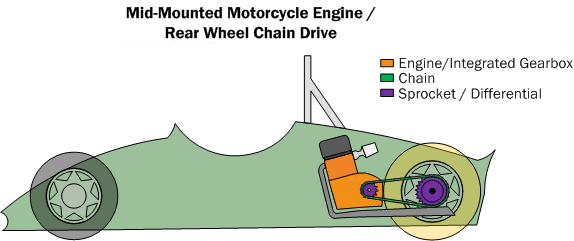
Diagram PC5. Mid-mounted motorcycle engine with rear wheel chain drive. This powertrain is one of the most popular for scratch builders because of the integrated engine/gearbox.
Mid-Engine/Four Wheel Drive
The mid-engine/4WD configuration pictured below in diagram PC6 does not gain any significant advantage over the front-engine/4WD configuration. The static weight distribution is comparable, with the mid-engine position making achieving a balanced front/rear weight distribution easier. The four wheel drive system adds additional weight and complexity to the powertrain.
Acceleration is the biggest benefit of having 4WD, but there is little practical effect on braking performance except if engine braking is used. The 4WD system can have a stabilizing effect in turns when designed to counter acceleration oversteer.
The advantages of mid-engine layout noted above for Mid-engine/Rear drive also apply here as well, except for the fact that a propeller/drive shaft runs from the transaxle to the front of the car.
Applications: GT, Off-road Truck, Rally, Supercar
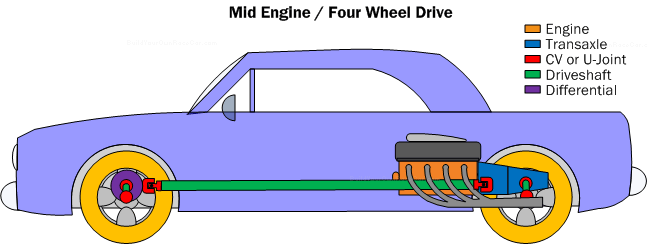
Diagram PC6. Supercar stuff. The mid-engine/four wheel drive powertrain is very popular for ultra-high horsepower supercars and some race cars. It combines the advantages of the mid-engine with the best available acceleration.
Rear Engine/Rear Drive
The rear engine/rear drive vehicle in diagram PC7 below demonstrates a configuration that has been put to use in racing in rare, but successful cases such as the Porsche 911. This configuration has the advantage of providing more weight transfer under acceleration than any other configuration. However, due to the leverage created by placing the engine outside the wheelbase, it has the negative side effect of reducing front wheel traction when under hard acceleration. Cars that make use of such a configuration generally escape significant penalty because they use lightweight engines and place the engine only a small distance past the rear axle.
Applications: Autocross/Solo, Dune Buggy, GT, Supercar
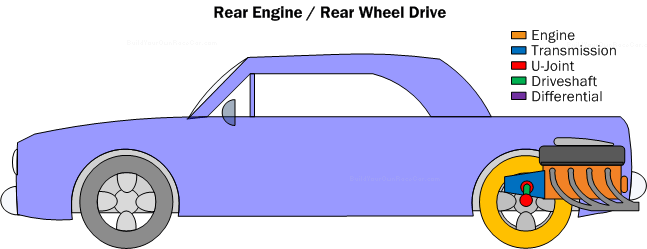
Diagram PC7. Rear engine/rear wheel drive powertrain configuration. Unusual, but well-executed by VW and Porsche. Using lightweight engines makes this configuration possible.
Rear Engine/Four Wheel Drive
Adding a four wheel drive drivetrain to the rear engine configuration provides a significant increase in acceleration even with rear weight transfer, but the inherent handicap of placing the engine outside the wheelbase still exists. However, as Porsche has demonstrated, the configuration can be made to work well. The more compact wheelbase of the rear-engine design also overcomes some of the polar moment and CG issues, when the static weight distribution is done well.
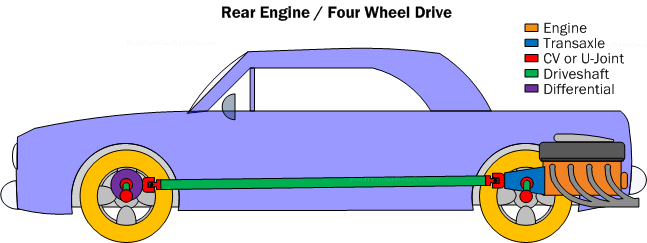
Diagram PC8. Rear engine/four wheel drive powertrain. The natural extension to the Rear engine/rear drive concept, having more weight up front and more traction ensures better performance.
Powertrain Tips (2/2)
Select Powertrain Components Before Designing the Chassis
While a basic conceptual drawing is needed to flesh-out your overall vehicle design, it is best to select major powertrain components before proceeding much further. Consider that the design of the chassis, overall weight distribution and suspension components all depend on the engine and driveline selected. The approximate mass and power of the engine and the mass and loading of the driveline are basic, but important starting points.
Maximize Powertrain Durability
As most powertrain components at any but the top levels of racing are purchased off-the-shelf, the internal durability is probably something you won’t change. However, how components are fit into the package of the vehicle can make a big difference. For example, keeping axle half-shafts as close to in-line with the differential and uprights/knuckle CV joints on an independent suspension will ensure less wear and tear on the CV joints, longer lifespan and therefore lower costs.
Minimize Engine and Drivetrain Weight and CG Height
The lower and lighter a car is, the faster it will go. Having an engine capable of being placed low in the chassis will have a large impact on final performance. If the engine itself is lighter, than the excess weight you’ve saved can be used as ballast at the lowest possible CG height in the car.
Minimize Outboard Weight
The unsprung weight of the suspension can be reduced if outboard driveline components are optimized for weight. For example, on an independent suspension, the longer the length of the half-shafts used to reach the wheels, the stronger they will need to be. This means more mass and more strength is required, which adds to unsprung weight.
Recommended Further Reading
David Vizard's How to Build Horsepower A guide to designing the engine as a system and constructing it to produce maximum horsepower. The design aspects use the airflow through each part of the engine as a basis for instruction. Provides detailed information on how to select, modify and tune each component to work at peak efficiency with others in the engine.
Get "David Vizard's How to Build Horsepower":


Racing Engine Builder's Handbook: How to Build Winning Drag, Circle Track, Marine and Road Racing Engines Practical tips and techniques on building a racing engine. This book covers applications such as drag racing, circle track, road racing and boats. The author's approach looks at math used in modifications, combined with examples and guidance on when and how to apply complimentary modifcations.
Get "Racing Engine Builder's Handbook: How to Build Winning Drag, Circle Track, Marine and Road Racing Engines":


How to Build Motorcycle-engined Racing Cars How to design and construct a motorcycle engine powered race car. This book explains how select and integrate the engine into a car as well as the design of the other aspects such as chassis, powertrain, brakes, fuel, coolant and electrics.
Get "How to Build Motorcycle-engined Racing Cars":


- View all powertrain books
Continue on to Car Aerodynamics Basics, How-To & Design Tips…
22 1 29 5
 Page: 1 2
Page: 1 2